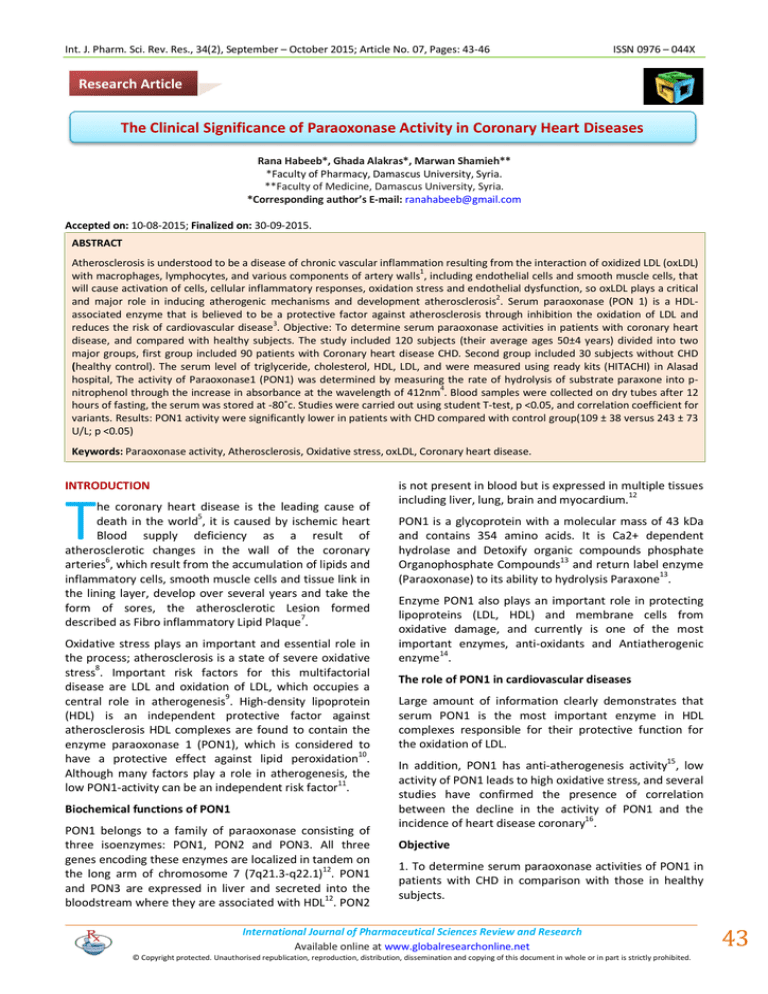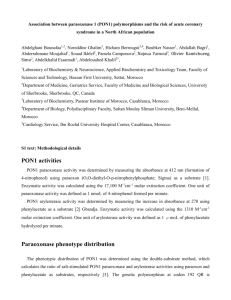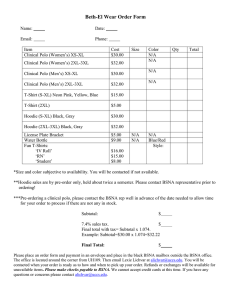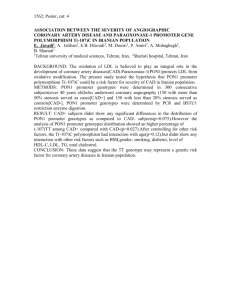Document 13310653
advertisement

Int. J. Pharm. Sci. Rev. Res., 34(2), September – October 2015; Article No. 07, Pages: 43-46 ISSN 0976 – 044X Research Article The Clinical Significance of Paraoxonase Activity in Coronary Heart Diseases Rana Habeeb*, Ghada Alakras*, Marwan Shamieh** *Faculty of Pharmacy, Damascus University, Syria. **Faculty of Medicine, Damascus University, Syria. *Corresponding author’s E-mail: ranahabeeb@gmail.com Accepted on: 10-08-2015; Finalized on: 30-09-2015. ABSTRACT Atherosclerosis is understood to be a disease of chronic vascular inflammation resulting from the interaction of oxidized LDL (oxLDL) 1 with macrophages, lymphocytes, and various components of artery walls , including endothelial cells and smooth muscle cells, that will cause activation of cells, cellular inflammatory responses, oxidation stress and endothelial dysfunction, so oxLDL plays a critical 2 and major role in inducing atherogenic mechanisms and development atherosclerosis . Serum paraoxonase (PON 1) is a HDLassociated enzyme that is believed to be a protective factor against atherosclerosis through inhibition the oxidation of LDL and 3 reduces the risk of cardiovascular disease . Objective: To determine serum paraoxonase activities in patients with coronary heart disease, and compared with healthy subjects. The study included 120 subjects (their average ages 50±4 years) divided into two major groups, first group included 90 patients with Coronary heart disease CHD. Second group included 30 subjects without CHD (healthy control). The serum level of triglyceride, cholesterol, HDL, LDL, and were measured using ready kits (HITACHI) in Alasad hospital, The activity of Paraoxonase1 (PON1) was determined by measuring the rate of hydrolysis of substrate paraxone into p4 nitrophenol through the increase in absorbance at the wavelength of 412nm . Blood samples were collected on dry tubes after 12 hours of fasting, the serum was stored at -80˚c. Studies were carried out using student T-test, p <0.05, and correlation coefficient for variants. Results: PON1 activity were significantly lower in patients with CHD compared with control group(109 ± 38 versus 243 ± 73 U/L; p <0.05) Keywords: Paraoxonase activity, Atherosclerosis, Oxidative stress, oxLDL, Coronary heart disease. INTRODUCTION T he coronary heart disease is the leading cause of death in the world5, it is caused by ischemic heart Blood supply deficiency as a result of atherosclerotic changes in the wall of the coronary arteries6, which result from the accumulation of lipids and inflammatory cells, smooth muscle cells and tissue link in the lining layer, develop over several years and take the form of sores, the atherosclerotic Lesion formed described as Fibro inflammatory Lipid Plaque7. Oxidative stress plays an important and essential role in the process; atherosclerosis is a state of severe oxidative 8 stress . Important risk factors for this multifactorial disease are LDL and oxidation of LDL, which occupies a central role in atherogenesis9. High-density lipoprotein (HDL) is an independent protective factor against atherosclerosis HDL complexes are found to contain the enzyme paraoxonase 1 (PON1), which is considered to have a protective effect against lipid peroxidation10. Although many factors play a role in atherogenesis, the low PON1-activity can be an independent risk factor11. Biochemical functions of PON1 PON1 belongs to a family of paraoxonase consisting of three isoenzymes: PON1, PON2 and PON3. All three genes encoding these enzymes are localized in tandem on 12 the long arm of chromosome 7 (7q21.3-q22.1) . PON1 and PON3 are expressed in liver and secreted into the 12 bloodstream where they are associated with HDL . PON2 is not present in blood but is expressed in multiple tissues including liver, lung, brain and myocardium.12 PON1 is a glycoprotein with a molecular mass of 43 kDa and contains 354 amino acids. It is Ca2+ dependent hydrolase and Detoxify organic compounds phosphate Organophosphate Compounds13 and return label enzyme (Paraoxonase) to its ability to hydrolysis Paraxone13. Enzyme PON1 also plays an important role in protecting lipoproteins (LDL, HDL) and membrane cells from oxidative damage, and currently is one of the most important enzymes, anti-oxidants and Antiatherogenic enzyme14. The role of PON1 in cardiovascular diseases Large amount of information clearly demonstrates that serum PON1 is the most important enzyme in HDL complexes responsible for their protective function for the oxidation of LDL. In addition, PON1 has anti-atherogenesis activity15, low activity of PON1 leads to high oxidative stress, and several studies have confirmed the presence of correlation between the decline in the activity of PON1 and the 16 incidence of heart disease coronary . Objective 1. To determine serum paraoxonase activities of PON1 in patients with CHD in comparison with those in healthy subjects. International Journal of Pharmaceutical Sciences Review and Research Available online at www.globalresearchonline.net © Copyright protected. Unauthorised republication, reproduction, distribution, dissemination and copying of this document in whole or in part is strictly prohibited. 43 © Copyright pro Int. J. Pharm. Sci. Rev. Res., 34(2), September – October 2015; Article No. 07, Pages: 43-46 MATERIALS AND METHODS ISSN 0976 – 044X cholesterol, total cholesterol and triglycerides and HDL values (115 ± 11, 173 ± 12, 141 ± 10, 40 ± 5) mg/dl respectively (P0<.05) Figure 1. Patients The study included 130 subjects (their average ages 50±4 years) divided into two major groups: -Group I: patients with coronary heart group included 90 patients from the Department of cardiac catheterization in Assad University Hospital, the patient was suffering from coronary heart disease if found to have a blockage of 50% or more in one of the coronary arteries as a result 17 of at least angiography was excluded patients with one chronic inflammatory, renal and hepatic diseases. -Group 2: (control group) included 40 healthy people who they have normal coronary vessels. Methods Blood samples were collected in dry tubes after fasting 12 hours, save serum were stored at -80˚ C for no more than a month. Ikm completed and assay HDL, LDL cholesterol, total cholesterol and triglyceride were measuring by used ready kits (ROCHE) by HITACH in Assad University Hospital. Analysis of PON1 Activity PON1 activity toward paraoxon was measured after the reaction of paraoxon hydrolysis into p-nitrophenol and diethylphosphate catalyzed by the enzyme. PON1 activity was determined from the initial velocity of p-nitrophenol production (subtracting the spontaneous paraoxon hydrolysis) at 37°C and recorded at 405 nm by an autoanalyzer (Cobas-Mira Plus, Roche Diagnostica)18. Serum was added to a basal assay mixture to reach final concentrations of 5 mmol/L paraoxon, 1.9 mmol/L CaCl2, 90 mmol/L Tris-HCl (at pH 8.5), and 3.6 mmol/L NaCl. A blank determination of basal assay mixture without serum was made to avoid spontaneous hydrolysis of diluted paraoxon solutions. A PON1 activity of 1 U/L was defined as 1 µmol of p-nitrophenol formed per minute. The molar extinction coefficient of p-nitrophenol is 18 053 (mol/L)−1 cm−1 at pH 8.5. The intra-assay and interassay coefficients of variation were 0.78% and 1.69%, respectively18. Figure 1: Compared the averages of lipid parameters between patients with coronary heart disease and control group PON1 Activity PON1 activity was (243 ± 73U/L) in control group, and the values ranged between (411-151U/L). Figure (2) shows distributes the activity of PON1 of members of this group. Figure 2: the distribution ofPON1 activity values in control group Statistical and Clinical Study computer program Statistica v6 was used to handle and analyse data, results are presented as means ± SD, a P values of ˂0.05 was accepted to indicate sta s cal significance and Persons test to study correlation between data. RESULTS The results of the study showed an increase statistically significant in the averages LDL-c, total cholesterol and triglyceride values of (126 ± 14,195 ± 13,190 ± 14 mg/dl) respectively and a decrease statistically significant in the average of HDL values (34 ± 9 mg / dl) in coronary heart patients group CHD compared with the control group (CON), which were the results of averages LDL Figure 3: correlation between the PON1 activity and HDL values at control group International Journal of Pharmaceutical Sciences Review and Research Available online at www.globalresearchonline.net © Copyright protected. Unauthorised republication, reproduction, distribution, dissemination and copying of this document in whole or in part is strictly prohibited. 44 © Copyright pro Int. J. Pharm. Sci. Rev. Res., 34(2), September – October 2015; Article No. 07, Pages: 43-46 The result show no significant correlation between the PON1 activity and HDL values at control group (0.05 <P) Figure (3). The serum PON1 activity coronary heart disease patients was (109 ± 38 U/L) has values ranging from (190-23 U/L), in Figure(4) shows the distribution of the values of the PON1 activity of members of this group ISSN 0976 – 044X synthesis of PON1 in the liver by reducing regulation (down regulation) mRNA for PON121. • High levels of plasma oxLDL which also lead to the 22 inhibition of the synthesis of PON1 in the liver. • High oxidative stress that leads to the depletion of PON1 and disable its activity through the interaction between lipid compounds oxidizing and free radicals with the enzyme-free sulfhydryl group23. Results of the study agree with the study (Graner) in 24 Finland. CONCLUSION We found through the study there is a strong correlation statistically significant between low PON1 activity and coronary heart diseases we can consider PON1 activity as independent risk marker for heart disease coronary. REFERENCES 1. Mackness I, Mackness B, Durrington N. Paraoxonase: biochemistry, genetics and relationship to plasma lipoproteins. CurrOpinLipidol, 7, 1999, 69-79. 2. Harel M. Structure and evolution of the serum paraoxonase family of detoxifying and anti-atherosclerotic enzymes. Nat. Struct. Med. Biol, 11, 2005, 412-419. 3. Sorensor R, Bisgaier C, Aviram M. Human serum paraoxonase retained hydrophobic N-terminal leader sequence associated with HDL by binding phospholipid. Arterioscler. Thromb. Vasc. Biol, 19, 2000, 2214-2225. 4. Primo P, Sorenson R, Teiber J. The human serum paraoxonasegene (PON 1) is one member of multigene family. Genomic, 33, 1997, 894-507. 5. Hegele R. Paraoxonase genes and disease. Ann Med. 31, 2001, 217-224. 6. Clendenning J, Humber R, Green D, Wood G. Structural organization of the human PON 1 gene. Genomics, 35, 1997, 586-589. 7. Brophy V, Hastinges M, Richter R. Polymorphisms in the human paraoxonase-1 promoter. Pharmacogenetics, 11, 2002, 77-84. Figure 5: Comparison of PON1 activity between coronary heart disease group and the control group 8. Mackness B, Durrington P, Mackness M. Human serum paraoxonase. Gen Pharmacol, 31, 1998, 329-336. Discusse: The results of study showed a variation in activity of enzyme in normal individual, and did not show a correlation of HDL and paraoxonase activity, and these due to genetic effects of PON 1, the results of our study agree with the results of a study (Wangx, 2004) in China19 and with the results of Mackness l study, 2003) in the UK20. Results of the study also showed a decrease in the activity of PON1 in patients with coronary disease group compared with the control group and the difference was statistically significant, lower PON1 in patients with atherosclerosis due to: The existence of the inflammatory process within the Atherosclerotic lesion that lead to reduced activity of PON1 through the influence of inflammatory cytokines, particularly INF, IL-1 on the 9. Navab M, Hama S, Hassan K, Hough G. Normal high-density lipoprotein inhibits three steps in the formation of mildly oxidized low-density lipoprotein: step 2 and 3. J. Lipid. Res, 41, 2000, 1495-1508. Figure 4: the distribution of PON1 activity values in control group The results show the PON1 activity were significantly lower in patients with CHD compared with control group (109 ± 38 versus 243 ± 73 U/L; p <0.05) figure 5. 10. Ashdy D, Rye K, Clay M. Factors influencing the ability of HDL to inhibit expression of vascular cell adhesion molecule-1 in endothelial cells. AtherosclerThrombVascBiol, 18, 2000, 1450-1455. 11. Mackness M, Arrol S, Abbott C. Protection of low-density lipoprotein against oxidative modification by high density lipoprotein associated paraoxonase. Atherosclerosis, 150, 1999, 129-135. 12. Waston A, Berliner J. Protective effect of high density lipoprotein associated paraoxonase. Inhibition of the International Journal of Pharmaceutical Sciences Review and Research Available online at www.globalresearchonline.net © Copyright protected. Unauthorised republication, reproduction, distribution, dissemination and copying of this document in whole or in part is strictly prohibited. 45 © Copyright pro Int. J. Pharm. Sci. Rev. Res., 34(2), September – October 2015; Article No. 07, Pages: 43-46 biological activity of minimally oxidized low density lipoprotein. J. Clin. Invest, 101, 1998, 2882-2891. 13. Sara P, Deakin W, Richard W. Genetic and environmental factors modulating serum concentrations and activities of the antioxidant enzyme paraoxonase-1. Clinical science, 107, 2005, 435-447. 14. Spyridon N. HDL-cholesterol: Pro-inflammatory and antiinflammatory effects. Hellenic J Cardiol, 45, 2005, 324-330. 15. Van L, Haman S, Beer F. Anti-inflammatory HDL becomes pro-inflammatory during the acute phase response. Loss of protective effect of HDL against LDL oxidation. Jclin Invest, 69, 1999, 2758-2767. 16. Pruzansk W, Stefans E. Comparative analysis of lipid composition of normal and acute-phase high density lipoproteins. Jlipid Res, 41, 2000, 1034-1047. 17. Class C, Wilztum J. Atherosclerosis: The road ahead. Cell, 104, 2002, 503-516. 18. Merdo L, Hgkoll O. The measurement of paraoxonase activity in serum. CoronArtrery Dis, 14, 2004, 245-260. 19. Wang X, Hung J, Fab Z, Su S, Zhen Y, Oing B, Gu D. Genetic and environmental factors associated with plasma paraoxonase activity in healthy Chinese. Chinese, 60, 2004, 135-146. ISSN 0976 – 044X 20. Mackness B, Mackness I. The hunt for nutritional and pharmacological modulators of paraoxonase. ArteriosclerThrombVasc Biol. 22(8), 2003, 1248-1280. 21. Stephens J, Humphries S. Increased plasma markers of oxidative stress are associated with coronary heart disease in male with diabetes mellitus and with 10-year risk in prospective sample of males. Clin chem. 52, 2006, 446-452. 22. Zamaklar M, Lalic K, Rajkovic N, Trifunovic D, Dragasevic M, Popovic L, Draskovic D. Oxidized LDL and lipids as risk factors for ischemic heart disease in type2 diabetes. Med. Con, 6, 2005, 500-520. 23. Holvoet P, Harris T, Tracy R, Verhamme P, Newman A, Rubin S, Simonsic E, Colbert L. Association of high coronary heart diseasc risk status with circulating oxidized LDL in the well-functioning elderly: findings from the health Aging, and body composition study. Arteriosclerthrombvasc boil, 23, 2003, 1444-1455. 24. Graner M, James R, Kabri J, Nieminen M, Syvanne M, Taskinen M. Association of paraoxonase-1 activity and concentration with angiographic severity and extent of coronary artery disease. Jam collcardiol, 2006, 2429-2437. Source of Support: Nil, Conflict of Interest: None. International Journal of Pharmaceutical Sciences Review and Research Available online at www.globalresearchonline.net © Copyright protected. Unauthorised republication, reproduction, distribution, dissemination and copying of this document in whole or in part is strictly prohibited. 46 © Copyright pro







